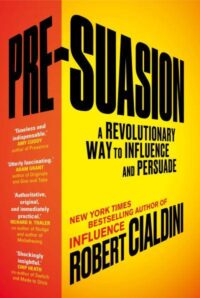Reading Notes for:


AND NOW FOR SOMETHING DIFFERENT: CHANGE-O, PRESTO
Whenever we first register a change around us, our attention flies to it. We are not alone in this regard. The reaction appears widely across the animal kingdom. It is so basic that it was able to overpower the most renowned behavior patterns of perhaps the most renowned group of animals in the history of psychological science: Pavlov’s dogs.
After many tests had convinced Pavlov of the reliability and strength of his momentous discovery of “classical conditioning,” he wanted to show it to others. Yet when visitors were invited to his institute to observe a demonstration, it usually failed.
It finally dawned on Pavlov that he could account for both breakdowns in the same way: upon entering a new space, both he and the visitors became novel (new) stimuli that hijacked the dog’s attention, diverting it from the bell and food while directing it to the changed circumstances of the lab.
The investigatory reflex. He understood that in order to survive, any animal needs to be acutely aware of immediate changes to its environment, investigating and evaluating these differences for the dangers or opportunities they might present. So forceful is this reflex that it supersedes all other operations.
Walking through doorways causes you to forget because the abrupt change in your physical surroundings redirects your attention to the new setting—and consequently from your purpose, which disrupts your memory of it.
More than a century after Pavlov’s characterization, our bodily reaction to change is no longer called a reflex. It’s termed the orienting response, and scores of studies have enlightened us about it.
The indication that has attracted recent scientific scrutiny takes place in the brain, where a pattern of electrical activity known as the “O-wave” (for orienting wave) flows across sectors associated with evaluation. By charting the rise and fall of O-waves in people hooked up to brain-imaging devices, neuroscientists have identified the kinds of stimuli that most powerfully produce shifts in attention. One such category of cues—associated with change—deserves our consideration, as it possesses intriguing implications for the psychology of influence.
A persuasion-oriented producer, writer, or director needs to be concerned principally with shots and cuts.
“You use your cuts to get people to swing attention to the parts of your message you really want them to focus on.”
That cut will instigate an orienting response to the winning feature in audience members’ brains before they even experience it.
TV advertisers have chosen instead to increase indiscriminately and dramatically the overall frequency of scene shifts within their ads by more than 50 percent over the years. Predictably, viewers end up confused as to the point of the ad and irritated by having their focus whipped around so often and so haphazardly. As a result, even though cut-heavy TV commercials draw more total attention, they produce significantly less memory for the ad’s persuasive claims and significantly less persuasion.
Present a piece of persuasive information in finalized, unchanging form—newspapers, magazines, books, handbills, window signs, billboards, emails, and so on—and, consequently, can’t use cuts to capture and direct audience attention strategically. To leverage the power of difference when employing these vehicles, persuaders typically resort to a more traditional tactic. They insert novelty into the appeal—that is, something designed to appear distinctive (original or unfamiliar or surprising) which also works well to attract attention.
Researchers gave online participants information about a pair of sofas we’ll call the Dream and the Titan. The two, manufactured by different furniture companies, were comparable in all respects except for their cushions. The Dream’s cushions were softer and more comfortable than the Titan’s but less durable.
In this one-on-one comparison, the potential customers preferred the Titan’s sturdier cushions to the Dream’s softer cushions, 58 percent to 42 percent. But that changed when the researchers sent the same information to another sample of online participants along with information about the features of three other sofa models.
The added sofas were not strong competitors, being weak on a variety of dimensions, but they all had durable cushions like the Titan. Within that set of comparisons, the Dream vaulted over all the other models—this time winning 77 percent of the preferred choices.
Adding three models with durable cushions made the Dream stand out as distinct from the other four possibilities on the feature of cushion softness and comfort—and distinctiveness, as we’ve seen, swings attention to the distinguishing factor
